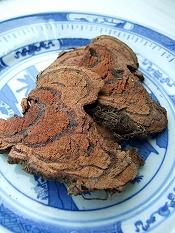Caulis Spatholobi
- Name
- Origin
- Where Does It Grow?
- Nature and Flavor
- Identified Active Components / Major Chemical Constituents
- Drug actions in TCM
- Traditional Uses in TCM
- Pharmacological Actions
- Administration and Dosage
- Adverse Effect, Side Effects and Cautions
- References

Name
Latin Name: Caulis Spatholobi Common Name: Spatholobus stem
Scientific Name: Spatholobus suberectus Dunn
Chinese Name: 雞血藤
Pinyin Name: ji xue teng
Origin
The dried stem of Spatholobus suberectus Dunn, a climbing shrub plant of the Leguminosae family.1Where Does It Grow?
Spatholobus stem is mainly produced in the Guangxi, Fujian, Guangdong and Yunan provinces of China.4
Nature and Flavor
Spatholobus stem is warm in nature, bitter and sweet in flavor, and mainly manifests its therapeutic actions in the liver meridian.2
Identified Active Components/ Major Chemical Constituents
Spatholobus stem has active components like flavonoids, triterpenes, anthraquinones and sterol derivatives.- Its flavonoids include formononetin, ononin, prunetin, afrormosin, cajanin, diadzein, genistein, isoliquiritigenin, licochalcone A, 3,4,2,4-tetrahydroxy chalcone, medicagol, 9-O-methylcoumestrol, 3,7-dihydroxy-6-methoxy-dihy-droflavonol, catechin, and epicatechin. Its triterpenes include friedelinol and friedelin; sterol and glycosides include β-sitosterol, daucosterol, 7-oxo-β-sitosterol, anthemisol, and stigmasterol; its anthraquinones include aloe-emodin and emodin-3-methyl ether.4-7Drug actions in TCM
Spatholobus stem activates and enriches blood, regulates menstruation, activates collaterals and releases tendons. 2Traditional Uses in TCM
Spatholobus stem is often used for conditions like sallow complexion due to blood deficiency, limb numbness, paralysis in the limbs or body, rheumatic joints, irregular menstruation, menstrual pain or missed periods. 2,3,6Spatholobus stem activates and enriches blood
The herb is suitable for women problems that caused by blood deficiency or blood stasis. For irregular menstruation, menstrual pain and missed periods that resulted from blood stasis, spatholobus stem can work with Sichuan lovage rhizome, Chinese safflower and nutgrass flatsedge rhizome for relief. In case if the problems are associated with blood deficiency, then spatholobus stem can work with processed rhemannia rhizome, angelica root and white peony root for relief.
Spatholobus stem activates collaterals and relax tendons
Spatholobus stem is a usual ingredient for meridian and collateral problems in the limbs. Rheumatic joints that develop joint pain and limb numbness, spatholobus stem can work with herbs like pubescent angelica root, clematis root and mulberry mistletoes to expel the wind and dampness pathogens in the limbs. Stroke that leads to numbness and paralyzed limbs, spatholobus stem can work with herbs like astragalus root, red sage root and earthworm to unblock the meridians and collaterals in the limbs. Blood deficiency that fails to nourish the tendons and muscles, individuals may have limb numbness and sallow complexion, spatholobus stem can work with herbs like astragalus root, and angelica root to replenish qi (vital energy) and enrich blood. Modern TCM also uses spatholobus stem for leukopenia (a decrease in the number of white blood cells), and hyperplasia of the mammary glands, that are usually treated along with other herbs.
Pharmacological Actions
Studies showed that spatholobus stem has effects in promoting hematopoiesis function, expanding blood vessels, anti-coagulation, enhancing uterine contraction, reducing blood lipid, anti-tumor, anti-virus, immune modulation, anti-inflammation, antioxidant, tranquilizing and promoting sleep. 2,3,5-7Administration and Dosage
Taking orally, spatholobus stem is suggested for 10〜15g, or it can be higher to 30g in decoction. Traditionally, the herb is often made into medicinal wine or syrup for long term consumption. 2,3Adverse Effect, Side Effects and Cautions
Individuals who are yin vacuity with internal heat or pregnant should use spatholobus stem with caution. 2,6References
- Li Jiashi (editor-in-chief), Chinese Medicine Identification, Shanghai Scientific and Technical Publishers, 2000-2.
- Lui Daiquan (editor-in-chief), Chinese Herbal Medicine, Shanghai Scientific and Technical Publishers, 2000-6.
- Chen Pian, Clinical Application of Tonifying Herbs, Second Military Medical University Press, 2008-8.
- The Institute of Medicinal Plant Development et al, A Record on Chinese Medicinal Herbs, People’s Medical Publishing House, 1994-1.
- Miao Mingsan et al (editor-in-chief), Modern Practice on Chinese Medicine Quality Control Techniques, People's Medical Publishing House, 2000-12.
- http://www.baike.com/wiki/%E9%B8%A1%E8%A1%80%E8%97%A4
- http://wenku.baidu.com/view/e5f87a48852458fb770b5636.html


